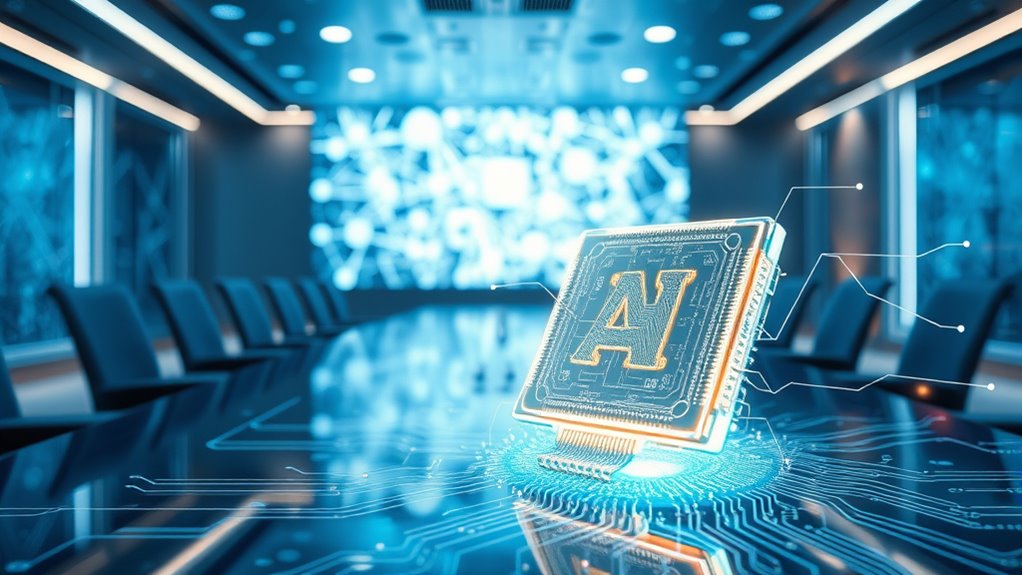OpenAI has announced GPT-5, its most advanced AI with remarkable “thinking” and reasoning skills that get closer to human understanding. This new model improves on previous versions, tackling complex tasks and generating more nuanced, accurate responses. While it holds great promise for industries like education and healthcare, it also raises concerns about misuse and ethical challenges. To learn more about how GPT-5 could impact society and what’s next, keep exploring this exciting development.
Key Takeaways
- GPT-5 introduces advanced “thinking” capabilities, enabling more nuanced understanding and problem-solving.
- It significantly improves language comprehension, handling complex tasks with higher accuracy.
- OpenAI emphasizes responsible deployment to mitigate risks like bias, misinformation, and misuse.
- The model’s power raises societal impacts, including potential industry transformations and ethical considerations.
- Ongoing oversight and regulation are crucial to ensure GPT-5’s benefits align with moral and societal values.

OpenAI has just revealed GPT-5, its latest advancement in artificial intelligence, promising to considerably enhance the capabilities of language models. This new iteration isn’t just about better text generation; it’s about giving AI a more nuanced understanding, almost like “thinking” capabilities. As you explore GPT-5, you’ll notice how it handles complex tasks, reasoning, and problem-solving with a level of sophistication that pushes the boundaries of previous models. However, with such power comes a critical conversation about AI ethics and the future implications of deploying these advanced systems.
You might wonder how GPT-5 impacts the broader landscape of AI ethics. As these models become more autonomous and human-like, questions about bias, fairness, and transparency grow more urgent. You’ll need to contemplate how this technology can be aligned with societal values and moral principles. Ensuring GPT-5’s outputs are unbiased and ethically sound isn’t just about programming; it involves ongoing oversight, diverse training data, and transparent development processes. Recognizing this, OpenAI emphasizes responsible deployment, but as a user or developer, you’re responsible for understanding and mitigating potential misuse or unintended consequences.
Thinking about future implications, GPT-5’s abilities could revolutionize many industries—education, healthcare, customer service, and more. Yet, this transformation raises concerns about job displacement, misinformation, and privacy. You’ll want to stay informed on how to leverage GPT-5 safely and ethically, ensuring that its deployment benefits society rather than exacerbating inequalities or creating new risks. The model’s thinking-like capabilities could also lead to misuse, like generating convincing fake news or manipulating public opinion. That’s why ongoing regulation and ethical guidelines are essential as the technology advances.
Frequently Asked Questions
Will GPT-5 Replace Human Workers in Creative Fields?
GPT-5 won’t replace human workers in creative fields entirely, but it might raise automation concerns. You’ll find it useful for brainstorming, generating ideas, or enhancing your work, fostering creative collaboration. Instead of replacing you, it acts as a tool to boost your creativity and productivity. Embrace this AI as a partner, helping you explore new possibilities while you focus on the uniquely human touch only you can provide.
How Does GPT-5 Handle Sensitive or Biased Content?
You might think GPT-5’s got it all figured out, but don’t worry, it’s still learning to handle sensitive or biased content. Thanks to bias mitigation techniques and content moderation, it filters out harmful or biased material, aiming to promote fairness. While it’s not perfect, it’s designed to recognize and minimize issues, helping create safer, more responsible AI interactions. Just remember, even AI needs a bit of human oversight!
Can GPT-5 Understand Emotions Like Humans Do?
You might wonder if GPT-5 truly understands emotions like humans do. While it excels in emotion recognition and can generate responses that seem empathetic, it doesn’t experience feelings itself. It analyzes patterns in language to simulate empathy, making it an effective empathetic AI. So, although it can recognize and respond to emotional cues, it lacks genuine emotional understanding, functioning instead through sophisticated pattern recognition.
What Are the Safety Measures Implemented With GPT-5?
Safety measures are the backbone of GPT-5, guiding it through the labyrinth of AI regulation and ethical guidelines. You’re protected by robust content filters, continuous monitoring, and strict adherence to ethical standards, ensuring responsible use. OpenAI’s proactive approach aims to prevent misuse, like a lighthouse guiding ships safely. By embedding these safety nets, GPT-5’s power stays a beacon of progress, not peril, safeguarding your interactions and fostering trust.
How Accessible Will GPT-5 Be to the General Public?
GPT-5’s accessibility to the public depends on ongoing AI regulation and data privacy considerations. You might find it available through OpenAI’s API or integrated into platforms, but strict controls could limit widespread use initially. OpenAI prioritizes safety, so they’ll balance accessibility with responsible deployment to protect user data and ensure ethical AI use. Expect gradual availability, with updates reflecting evolving regulation and privacy standards.
Conclusion
With GPT-5’s advanced thinking abilities, you might soon see it revolutionize industries. Imagine a healthcare provider using GPT-5 to analyze complex medical data, leading to faster diagnoses and personalized treatments. As this technology evolves, you’ll discover new ways it can enhance your work and daily life, making tasks more efficient and insightful. The future with GPT-5 promises significant breakthroughs—it’s an exciting step toward smarter, more intuitive AI.











